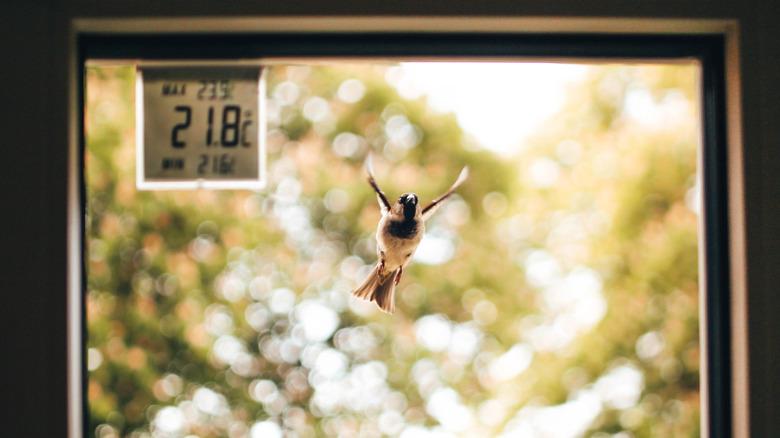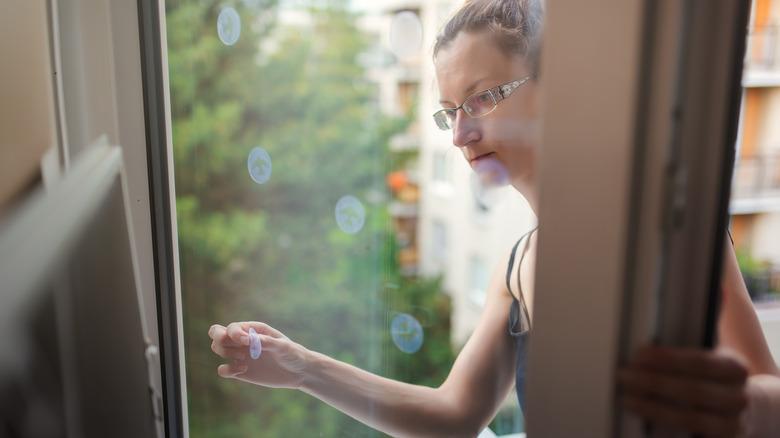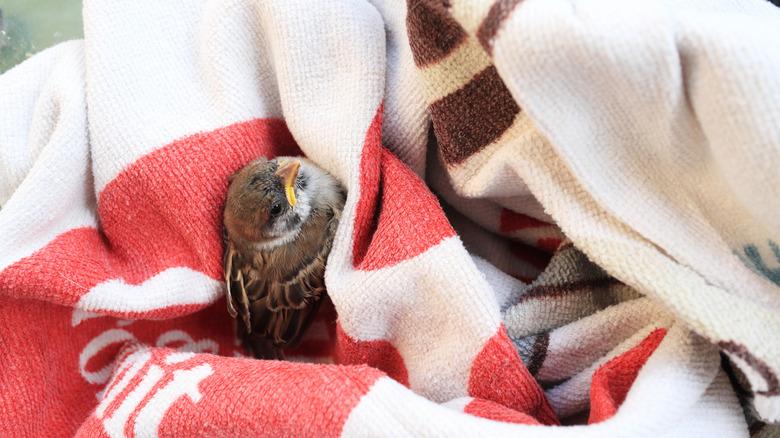Easy Ways To Stop Birds From Flying Into Your Windows
It may sound like something out of a slapstick comedy, but the chance of a bird flying into your windows is actually alarmingly high. According to a study published in The Condor: Ornithological Applications, up to 1 billion birds a year meet their untimely end due to collisions with buildings and windows. But fortunately for us and our avian neighbors, there are plenty of remedies to mitigate a potential bird hazard outside of your home. From window films and treatments to bird-friendly decals on glass, these solutions are as easy or as extensive as you want them to be and will keep your home bird-accident free.
You may be wondering why the statistic is so high for bird deaths. There is actually a direct correlation with the increased use of glass in our modern buildings to an uptick in bird collisions, mostly due to the material's reflective nature. Glass reflects greenery and the sky around the house or building, making the horizon appear to stretch further for a bird. They run into the window thinking they're flying towards open space, not a house. Furthermore, artificial lighting emitting from windows is believed to disorient birds as well. This sort of light confuses birds to the point of collision since they're drawn toward the light inside the buildings. Use of glass and lighting aside, we can all do our part, though, to decrease the number of bird collision deaths with several home solutions that'll make our windows seem less discombobulating to the birds around us.
Methods that help stop birds from flying into windows
The easiest way to prevent birds from flying into your windows is by simply closing your shutters, curtains, or blinds to mitigate reflection, and therefore risk to the birds. If that's not preferred, then planting shrubs or plants in front of the windows acts as a buffer to break up the reflection and make it more obvious that it's not an extension of the sky. Anything you can do to visually break up the horizon will help our flying friends. Just be sure to keep your bird-friendly gardens far enough away from the house to maintain a safe distance.
Other easy methods include creating visual cues for birds to follow. Adding a significant amount of decals to a window, for example, provides a signal that there is an obstruction in front of flying birds. For added measure, you can add hawk decals as these will appear like there's both an obstruction as well as a predator looming about — just note that a single hawk sticker isn't going to cut it (the more the better).
For heftier fixes, consider adding an exterior awning over your windows to shade the glass, and again break up the line of sight and reflective surface for any approaching birds. Another more dramatic approach is to fully treat your windows. There are products on the market, like one-way view, non-reflective film, that can make glass less reflective and therefore less tempting for birds to fly into. Bug screens have the same effect as well. As an added note, putting your bird bath in the wrong spot matters, since tempting amenities can lure birds towards the danger zone, thus try to keep baths and feeders at least 3 feet away from the windows.
Other concerns about birds, windows, and injuries
There are a few other concerns with birds and windows that you should keep an eye out for as well. For instance, birds are known to attack windows as much as they fly into them. For the same reasons why a bird may think it can fly into your window, the reflective surface of the window may make male birds think there is another, competing male nearby. This makes some species of bird, particularly territorial ones during mating season, take a stab (literally) at his reflection. When this happens, birds can injure their beaks and scratch your windows.
When injury does occur, whether from flying into the window or aggressively pecking at it, there are a few ways you can aid a bird in its recovery. First, try to find the bird and if it appears that can not bounce back from its own injuries — maybe it's stunned or perhaps it sustained an injury that won't let it fly — then put on some gardening gloves and scoop the bird up. Sometimes, the bird just needs a few moments to regather itself, but if it's truly injured and cannot fly, then it's best to gently wrap the bird up in some fabric, like a towel, and place it in a shoe box or Tupperware until you can transfer it to a wildlife rehabilitation organization. While you may have the best intentions to keep the bird and nurse it back to health yourself, sadly, most folks aren't equipped to do it correctly. It's also unlawful in many places to keep a wild bird in captivity without the proper permits and permissions. Thus, it's in the bird's best interest to get handled and healed by professionals.


